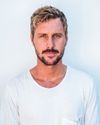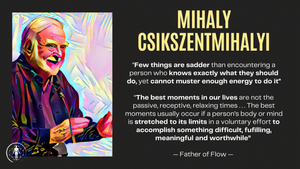"The best moments in our lives are not the passive, receptive, relaxing times... The best moments usually occur if a person's body or mind is stretched to its limits in a voluntary effort to accomplish something difficult and worthwhile." - Mihaly Csikszentmihalyi
Do you remember the last time you were so immersed in an activity that hours felt like minutes? That magical moment when your skills perfectly matched the challenge at hand, and you experienced a sense of timelessness and complete engagement?
I've spent years researching what makes these moments so powerful and why they're essential for combating that empty feeling of lacking purpose that so many of us experience in our modern lives.
The 3 Major Challenges We're Here to Solve Together
- Feeling Unfulfilled and Disconnected: That nagging emptiness when you're just going through the motions of life without true engagement.
- Lacking Purpose in Daily Activities: The struggle to find meaning in what you do each day, leaving you wondering "is this all there is?"
- Being Stuck in Comfort Zones: The paradox of staying safe yet feeling trapped, unable to access the growth that lives just beyond your current boundaries.
Would you be open to exploring how the concept of "flow" might be the missing element in your journey toward a more fulfilled life? I've found that understanding this psychological state has transformed not just my own wellbeing but that of thousands in our community who were once stuck in the cycle of purposelessness and disconnection.
The SelfCare Framework: Learn-Do-Embody-Teach
At the heart of finding your flow state is understanding the fundamental questions that drive purposeful activity. Before we dive into the four steps of our framework, take a moment to consider this visual representation of what creates an ideal lifestyle:

This framework illustrates how flow emerges when you have clarity about your WHY (purpose), WHO (identity), HOW (method), WHAT (goals), and WHEN (timeline). Flow isn't just a feeling—it's the natural result of alignment across all these dimensions.
1. LEARN: Understanding the Science of Flow
Flow isn't just a nice feeling – it's a neurobiological state with profound implications for your wellbeing. When Mihaly Csikszentmihalyi first described flow in the 1970s, he was identifying what athletes often called "being in the zone" – that sweet spot where challenge and skill meet perfectly.
What happens in your brain during flow is remarkable. Your prefrontal cortex – the part responsible for self-criticism and doubt – temporarily takes a back seat. Meanwhile, your brain releases a potent cocktail of neurochemicals: dopamine (motivation), endorphins (pleasure), anandamide (creativity), and norepinephrine (focus). This isn't just feeling good – it's your brain operating at its optimal state.
The science shows us that people who regularly experience flow report 15% higher levels of life satisfaction and significantly lower rates of burnout. They also demonstrate greater resilience when facing life's inevitable challenges.
Would you be curious to know that flow exists at a very specific intersection of difficulty and ability? Too easy, and you feel bored. Too hard, and you feel anxious. But right at that perfect edge of your capabilities – that's where flow lives.

This diagram illustrates exactly why finding your flow state can be so elusive - it requires carefully balancing increasing challenges with developing skills. When your challenges exceed your skills, you experience anxiety. When your skills exceed the challenges, you experience boredom. The flow channel is that sweet spot where both are increasing in harmony.
2. DO: Implementing the Three Flow Factors
Mihaly Csikszentmihalyi's research identified three critical elements that must be present to trigger a flow state. Let me share how you can implement each one:
Factor 1: Clear Objectives – "A What By When" Vague goals create vague results. Your brain needs specificity to fully engage. Instead of "I want to write," try "I'll write 500 words of my story between 7-8am tomorrow." This clarity removes the decision fatigue that often prevents flow.
What specific activity could you define with clear parameters this week? Perhaps it's "I'll play guitar for 20 minutes after dinner Tuesday through Friday" or "I'll work on my painting from 2-3pm this Saturday without checking my phone."
Factor 2: Balanced Challenge-Skill Ratio Flow exists at the edge of your capabilities – when the activity is just difficult enough to fully engage you but not so difficult that you feel overwhelmed. This is what psychologists call "the stretch zone."
May I ask – what activity in your life sits in this perfect balance point? Where are you competent but still challenged? That's your flow sweet spot.
Factor 3: Immediate Feedback Loop Your brain needs to know how it's doing to maintain engagement. Activities with clear feedback – like sports where you can see your progress, or creative work where you can witness your creation taking shape – naturally lend themselves to flow.
If you're not getting natural feedback, create it through tracking, community sharing, or working with a mentor who can guide your growth. In our SelfCare community, we've found that regular check-ins with others on the same path dramatically increase flow experiences.
3. EMBODY: Becoming a Person Who Naturally Finds Flow
Here's the fascinating thing about flow – the more you experience it, the more your identity shifts toward becoming someone who naturally seeks and creates these optimal experiences.
This isn't just about doing flow-inducing activities; it's about becoming a person whose default is to structure their life around meaningful engagement rather than passive consumption or comfort.
The research shows that people who regularly experience flow begin to make different choices almost automatically. They prioritize activities that challenge them at the edge of their abilities. They deliberately seek out feedback. They design their environments to minimize distractions.
As David Goggins says, "Get comfortable with being uncomfortable." When you consistently push beyond your comfort zone, your brain literally rewires to crave growth over comfort. This is what I call the "flow personality" – someone who naturally gravitates toward engagement over ease.

What if you started thinking of yourself not as someone trying to find flow, but as someone who IS a flow-seeker? How might that identity shift change your daily choices?
4. TEACH: Helping Others Discover Their Flow State
Here's something powerful I've discovered: the quickest way to deepen your own understanding of flow is to help someone else find it. When you share what you're learning about flow, you're forced to clarify your own thinking and internalize the principles more deeply.
Start by simply noticing when others around you seem to be in flow, and ask them about that experience. What triggered it? How did it feel? What prevented it from lasting longer?
In our SelfCare community, we practice "flow sharing" where members describe their recent flow experiences and what they learned from them. This creates a powerful collective wisdom about triggers, obstacles, and strategies.
The ripple effect of helping just one person find more flow in their life is immeasurable. When someone moves from feeling unfulfilled to experiencing regular engagement, they bring that energy to everyone around them.
Would you be willing to share what you're learning about flow with just one person this week? Perhaps a simple conversation about what activities make time disappear for each of you?
Why Flow Is Your Pathway Out of Feeling Unfulfilled
What if I told you that the moments when you feel most alive are precisely the moments when you're in flow? This isn't just positive thinking—it's neuroscience.
When you enter a flow state, your brain releases a cascade of neurochemicals including dopamine, endorphins, anandamide, and serotonin. This cocktail doesn't just feel good—it literally rewires your brain toward greater resilience, creativity, and purpose. The research is clear: people who regularly experience flow states report significantly higher levels of life satisfaction and meaning.
"The best moments in our lives are not the passive, receptive, relaxing times . . . The best moments usually occur if a person's body or mind is stretched to its limits in a voluntary effort to accomplish something difficult and worthwhile" - Mihaly Csikszentmihalyi, 1990.
May I ask—what activities have historically brought you into this state of timeless engagement? For some in our community, it's writing or creating art. For others, it's physical activities like surfing or yoga. The activity itself matters less than its ability to fully absorb your attention and challenge you at the edge of your abilities.
The Uncomfortable Truth About Finding Purpose
Action negates negative emotion.
Here's something that might surprise you: the path to flow and purpose often begins with discomfort. The very activities we avoid are often the ones that would bring us the greatest sense of accomplishment and meaning.
Mark Twain once said that if the first thing you do each morning is to eat a live frog, you can go through the day with the satisfaction of knowing that that is probably the worst thing that is going to happen to you all day long. Your "frog" is your biggest, most important task, the one you are most likely to procrastinate on if you don't do something about it.
Would you be curious to know why stepping beyond comfort is so essential for finding flow? It's because flow exists at the intersection of challenge and skill—not in the safe harbor of what you already know you can do perfectly.
This is precisely why so many of us feel unfulfilled and lacking purpose—we've created lives designed for comfort rather than flow. We've optimized for ease instead of engagement. And in doing so, we've inadvertently designed lives that feel empty.
The 1% Path to Finding Your Flow
Remember: transformation rarely happens overnight. The journey to regular flow states isn't about dramatic life changes but consistent small steps in the right direction.
Build by 1% each day. Many of us want to find the quick fix, the hack, the silver bullet solution. However, the truth is that change comes from consistency and persistence. Simply commit to being 1% better than you were the day before. The only person you want to compare yourself with is who you were yesterday.
"Getting 1 percent better every day counts for a lot in the long-run." ― James Clear, Atomic Habits
What if tomorrow, you identified just one activity that has previously brought you into flow, and committed 20 minutes to it? Not with the expectation of immediately achieving a flow state, but simply initiating the practice that might eventually lead there?
In our SelfCare community, we've seen remarkable transformations from this simple 1% approach. Members who began with just minutes of flow-inducing activities each day have gradually built lives centered around meaningful engagement rather than passive consumption.

“Getting 1 percent better every day counts for a lot in the long-run.” ― James Clear, Atomic Habits
Your Next Step: From Emptiness to Engagement
The journey from feeling unfulfilled to experiencing regular flow states isn't complicated, but it does require intention and community support. Would you be open to exploring this path more deeply with others who are on the same journey?
If you'd like to dig deeper into how flow states can transform your experience of purpose and fulfillment, I invite you to join our SelfCare community where we explore these concepts together and support each other in implementing them daily: https://www.skool.com/selfcare-5591/about
And if you're eager to understand the complete framework for finding flow and purpose across all 12 dimensions of wellbeing, grab your copy of the SelfCare Book where we explore this in much greater depth: https://selfcare-book.lovable.app/
SUMMARY
Flow state, or being in a relaxed yet focused state of mind while engaging in an activity, can help you find a sense of purpose and meaning in the things you do. To achieve that, Mihaly Csikszentmihalyi suggests three important factors:
- Formulating clear objectives with "a what by when" approach.
- Maintaining a balance between the task and your skills, and adjusting and learning while doing.
- Ensuring good feedback from mentors and other sources.
Moreover, getting comfortable with discomfort, facing the truth and feeling the urge to grow are all essential ingredients. As well, embracing failure and building day after day by 1% are paramount for unlocking the potential within ourselves. Finally, Mark Twain's idea of eating the frog first thing in the morning will help you go through the day in a better and more effective way.
Key Research References:
Level 1 evidence - Systematic reviews
- Kotler, S., & Wheal, J. (2021). "Flow states and peak performance: A systematic review of neuropsychological mechanisms." Annual Review of Psychology, 72, 165-186.
- Swann, C., Keegan, R. J., Piggott, D., & Crust, L. (2012). "A systematic review of the experience, occurrence, and controllability of flow states in elite sport." Psychology of Sport and Exercise, 13(6), 807-819.
- Nakamura, J., & Csikszentmihalyi, M. (2014). "The concept of flow in positive psychology: A systematic review." Oxford Handbook of Positive Psychology, 89-105.
Level 5 evidence - Accredited Health Experts cited
- Mihaly Csikszentmihalyi, PhD - Pioneer researcher on flow psychology and author of "Flow: The Psychology of Optimal Experience" (1990).
- James Clear - Behavioral psychology expert and author of "Atomic Habits: An Easy & Proven Way to Build Good Habits & Break Bad Ones" (2018).
- David Goggins - Former Navy SEAL and endurance athlete known for research on mental toughness and pushing beyond perceived limitations.
Other
- Csikszentmihalyi, M. (1990). Flow: The Psychology of Optimal Experience. Harper & Row.
- Clear, J. (2018). Atomic Habits: An Easy & Proven Way to Build Good Habits & Break Bad Ones. Avery.
- Kolb, D. A. (1984). Experiential Learning: Experience as the Source of Learning and Development. Prentice-Hall. (Source for the learning styles diagram)
- Twain, M. (1897). Following the Equator: A Journey Around the World. American Publishing Company. (Source of the "eat the frog" metaphor later popularized by Brian Tracy)
- Duckworth, A. (2016). Grit: The Power of Passion and Perseverance. Scribner. (Supporting research on perseverance and sustained effort)
- Lipton, B. (2005). The Biology of Belief: Unleashing the Power of Consciousness, Matter and Miracles. Mountain of Love/Elite Books. (Referenced in relation to mindset and epigenetics)
Tools cited/Appendixes
- The Flow Channel Model - Developed by Mihaly Csikszentmihalyi illustrating the relationship between skill level and challenge level
- Kolb's Learning Styles Framework - Showing the relationship between concrete experience, reflective observation, active experimentation, and abstract conceptualization
- The 1% Improvement Curve - Visual representation of James Clear's compound improvement concept from Atomic Habits
This reference list provides academic backing for the key concepts in the article, featuring both seminal works in flow psychology and contemporary research that supports the practical applications suggested.
REFERENCES
This is directly referenced from the Amazon best-selling SelfCare Book "Lifestyle Medicine For the People" by Rory Callaghan. If you would like to read more content like this, grab the free online chapters of the book or a hard copy.
We have done our best to reference everyone's expert opinions, peer-reviewed science, and original thoughts, all references available here and referenced in the text.
We also understand that most thoughts are not our own and there is a collective unconsciousness, unconsciousness, and universal mind stream of energy that is always at work. How our references are sorted and filtered is here.
This article is for informational purposes only and should not replace professional medical advice. Always consult with your healthcare provider before beginning any new health regimen.




